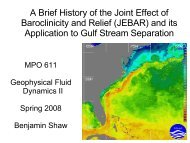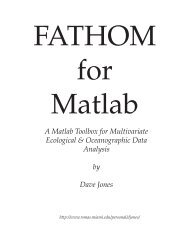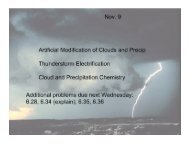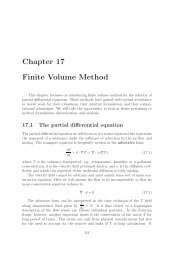2007 (PDF) - Rosenstiel School of Marine and Atmospheric Science ...
2007 (PDF) - Rosenstiel School of Marine and Atmospheric Science ...
2007 (PDF) - Rosenstiel School of Marine and Atmospheric Science ...
Create successful ePaper yourself
Turn your PDF publications into a flip-book with our unique Google optimized e-Paper software.
Oceans & Human Health<br />
Florida Red Tide <strong>and</strong> Asthma<br />
A study published in the January <strong>2007</strong> issue <strong>of</strong> CHEST, the<br />
peer-reviewed journal <strong>of</strong> the American College <strong>of</strong> Chest Physicians<br />
(ACCP), suggests that Florida red tide toxins (known as<br />
brevetoxins) can impact respiratory function <strong>and</strong> increase respiratory<br />
distress in patients with asthma. The article notes that though<br />
Florida red tides may affect everyone adversely, inhaled aerosolized<br />
brevetoxins may have a greater <strong>and</strong> longer lasting impact on patients<br />
with asthma.<br />
In the normal population, breathing in red tide toxins can lead to<br />
eye irritation, rhinorrhea, coughing, <strong>and</strong> wheezing. However, these<br />
symptoms usually subside after leaving beach areas.<br />
Dr. Lora E. Fleming, who holds joint appointments at both the<br />
University <strong>of</strong> Miami’s <strong>Rosenstiel</strong> <strong>School</strong> <strong>and</strong> Leonard M. Miller<br />
<strong>School</strong> <strong>of</strong> Medicine, <strong>and</strong> a team <strong>of</strong> researchers from academic, environmental,<br />
<strong>and</strong> government institutions funded by the National<br />
Institute <strong>of</strong> Environmental Health <strong>Science</strong>s (NIEHS), Centers for<br />
Disease Control <strong>and</strong> Prevention (CDC) <strong>and</strong> the Florida Department<br />
<strong>of</strong> Health, evaluated the exposures <strong>and</strong> effects <strong>of</strong> aerosolized<br />
red tide brevetoxins in 97 subjects with asthma. Participants spent<br />
at least one hour at Sarasota’s Siesta Beach during active Karenia<br />
brevis blooms <strong>and</strong> during a period when there was no bloom.<br />
Detailed baseline information was collected, <strong>and</strong> all participants<br />
underwent pre-<strong>and</strong> post-beach evaluations, including medical history<br />
questionnaires, nasal swab sampling, <strong>and</strong> lung function testing<br />
(spirometry). Each participant also carried a personal air monitor<br />
while at the beach. Throughout exposure <strong>and</strong> non-exposure periods,<br />
researchers collected water <strong>and</strong> air samples <strong>and</strong> monitored air<br />
temperature, relative humidity, <strong>and</strong> wind speed <strong>and</strong> direction.<br />
The study noted how far from the beach patients lived <strong>and</strong> their<br />
relative use <strong>of</strong> asthma medications within the 12 hours prior to the<br />
study. Inl<strong>and</strong> residents were more likely to report more symptoms<br />
<strong>and</strong> decreased respiratory function after toxin exposure. However,<br />
inl<strong>and</strong> residents had higher baseline spirometry scores, suggesting<br />
that coastal residents may already have decreased lung function<br />
from regular exposure prior<br />
to the study, <strong>and</strong>, therefore,<br />
reacted less to the one-hour<br />
beach exposure. Participants<br />
who reported using<br />
asthma medication within<br />
12 hours prior to the study<br />
had similar post-exposure differences in spirometry <strong>and</strong> respiratory<br />
symptoms compared with those who did not use medication.<br />
Research showed that for asthmatics, spending an hour walking on<br />
a beach during red tides, decreased their average lung capacity by a<br />
statistically significant, but modest decrease in lung function. For<br />
some asthma sufferers, full recovery <strong>of</strong> lung function took as long<br />
as five days.<br />
Florida red tides occur annually <strong>of</strong>f Florida’s Gulf coast, where<br />
blooms <strong>of</strong> Karenia brevis proliferate rapidly <strong>and</strong> produce potent<br />
aerosolized toxins. As these algae reproduce, the coastline <strong>of</strong>ten<br />
assumes a dark brown hue that can <strong>of</strong>ten stretch for miles. The tiny<br />
microorganisms secrete toxins into the water, killing fish, seabirds,<br />
<strong>and</strong> other marine organisms.<br />
Asthmatics <strong>and</strong> other<br />
patients with chronic<br />
respiratory illnesses,<br />
whether residents or<br />
tourists, need to be<br />
aware <strong>of</strong> the potential<br />
risks involved with<br />
Florida red tide <strong>and</strong><br />
how they might react to<br />
exposure. It is important<br />
for patients to take steps<br />
to reduce exposure,<br />
especially during times<br />
when Florida red tide<br />
levels are highest.<br />
A Sarasota County lifeguard is monitored during<br />
a red tide field study on Florida’s west coast.<br />
Photo credit: Barbara Kirkpatrick<br />
Hurricanes & Health<br />
For most, the aftermath <strong>of</strong> a hurricane brings thoughts <strong>of</strong> flattened<br />
homes, uprooted trees, <strong>and</strong> water damage to property left st<strong>and</strong>ing<br />
once the wind <strong>and</strong> rain stop. But it is the dust <strong>and</strong> organic debris<br />
pumped into the area by the strong winds <strong>and</strong> storm surge that<br />
may pack the hardest punch -- the potential for illness <strong>and</strong> even<br />
death – long after the storm has passed.<br />
As part <strong>of</strong> a study assessing urban sediment after Hurricanes Katrina<br />
<strong>and</strong> Rita, scientists from the University <strong>of</strong> Miami published<br />
findings in an April <strong>2007</strong> issue <strong>of</strong> the Proceedings <strong>of</strong> the National<br />
Academy <strong>of</strong> <strong>Science</strong>s, pointing to the need for rapid environmental<br />
assessments as part <strong>of</strong> preventative disaster relief policies. The study,<br />
entitled “Impacts <strong>of</strong> Hurricanes Katrina <strong>and</strong> Rita on the Microbial<br />
L<strong>and</strong>scape <strong>of</strong> the New Orleans Area,” provided new insights into<br />
the potential for human exposures to both inhaled <strong>and</strong> ingested<br />
pathogens from sewage-contaminated floodwaters generated by<br />
hurricane activity.<br />
Dr. Helena Solo-Gabriele, pr<strong>of</strong>essor <strong>of</strong> Civil <strong>and</strong> Environmental<br />
Engineering at the University <strong>of</strong> Miami <strong>and</strong> co-author <strong>of</strong> the<br />
paper, along<br />
with colleagues<br />
at the NSF/<br />
NIEHS Center<br />
for Oceans <strong>and</strong><br />
Human Health<br />
(OHH) based<br />
at the <strong>Rosenstiel</strong><br />
<strong>School</strong>,<br />
researchers from<br />
five universities,<br />
<strong>and</strong> two other<br />
NSF/NIEHS<br />
Dr. Helena Solo-Gabriele takes a sediment sample in New<br />
Orleans after Hurricane Katrina. Photo credit: Brajesh<br />
Dubey<br />
Centers for<br />
OHH, analyzed<br />
water <strong>and</strong> sediment<br />
samples in<br />
New Orleans during the two<br />
months following the 2005<br />
hurricane season. Samples<br />
from the interior canal <strong>and</strong><br />
shoreline <strong>of</strong> New Orleans, <strong>and</strong><br />
the <strong>of</strong>fshore waters <strong>of</strong> Lake<br />
Pontchartrain showed higher<br />
than normal bacteria <strong>and</strong><br />
pathogen levels. The microbial<br />
levels reduced to acceptable<br />
levels within a few weeks after<br />
the intense flooding completely<br />
subsided.<br />
Dried sediment covers the porch <strong>of</strong> a home<br />
after Hurricane Katrina, near New Orleans’<br />
London Street Canal. Photo credit:<br />
Maribeth Gidley<br />
Public health impacts <strong>of</strong><br />
hurricanes vary depending on a number <strong>of</strong> factors. Initial threats<br />
may include drowning due to storm surge or rainfall flooding, with<br />
additional risks from high winds <strong>and</strong> potential tornadoes spawned<br />
by the storm. Emergency response teams face serious public health<br />
risks when attempting rescues, both during <strong>and</strong> after natural disasters.<br />
Findings show the importance <strong>of</strong> a rapid assessment <strong>of</strong> conditions<br />
to protect emergency workers <strong>and</strong> residents from potential<br />
illnesses that could result from exposure.<br />
The 2005 events were characterized by an unusually high volume<br />
<strong>and</strong> long duration <strong>of</strong> human exposure to potentially dangerous<br />
microbes. The most contaminated area tested near the Superdome<br />
contained high levels <strong>of</strong> sewage pathogens. Researchers underscore<br />
the need for improved monitoring efforts that focus on evaluating<br />
the impacts <strong>of</strong> sediments in affected areas, since exposure to contaminated<br />
sediments through inhalation or ingestion, could result<br />
in potential health risks.<br />
Scientists have long been aware that with hurricanes come the<br />
potential for disease, chemical contamination <strong>and</strong> even death. But<br />
concerted efforts are now being undertaken to study <strong>and</strong> underst<strong>and</strong><br />
the connections between them <strong>and</strong> how at-risk communities<br />
might add another level <strong>of</strong> preparedness to their hurricane preparation<br />
<strong>and</strong> response.<br />
Where We Swim & Play<br />
Hobie Beach, Florida<br />
In fall <strong>2007</strong>, the University <strong>of</strong> Miami’s NSF NIEHS Oceans <strong>and</strong> Human Health Center, the Centers for<br />
Disease Control <strong>and</strong> Prevention, the Florida Department <strong>of</strong> Health, the Miami-Dade County Health<br />
Department, Nova Southeastern University, NOAA, University <strong>of</strong> Florida <strong>and</strong> other collaborators<br />
kicked <strong>of</strong>f an interdisciplinary epidemiological study on Hobie Beach, Florida. Investigators wanted to<br />
find out if regular beachgoers in marine recreational waters with no known point sources <strong>of</strong> pollution<br />
experience any adverse health effects from swimming in subtropical water <strong>of</strong>ten cited for contamination<br />
with infectious microorganisms. Similar studies have been done in Great Britain, Spain <strong>and</strong> Hungary<br />
-- but this is the first time it is being done in a sub-tropical climate.<br />
The research team is recruiting nearly 1,300 participants through June 2008. After completing baseline<br />
<strong>and</strong> pre-exposure questionnaires, adult residents <strong>of</strong> South Florida who regularly use recreational<br />
marine waters are asked to either: a) enter the water or b) remain on the beach for 15 minutes, with<br />
those sitting on the beach serving as the control group for the study. Individuals r<strong>and</strong>omly selected<br />
to enter the water, submerge their entire body <strong>and</strong> collect a water<br />
sample in a five gallon receptacle for microbial analyses (e.g. bacteria,<br />
viruses, parasites). Researchers then schedule a telephone interview<br />
for a follow up questionnaire about the person’s health to assess<br />
their well being over the seven days after exposure. Ultimately, the<br />
researchers will evaluate if reported health effects are associated<br />
with exposure to non-point source subtropical marine waters, <strong>and</strong> if<br />
the currently recommended microbial assessment methods protect human<br />
health.<br />
Julie Armstrong records pre-study baseline beach characteristics,<br />
such as number <strong>of</strong> people <strong>and</strong> dogs on the beach. Photo credit: Julie<br />
Hollenbeck<br />
19 20


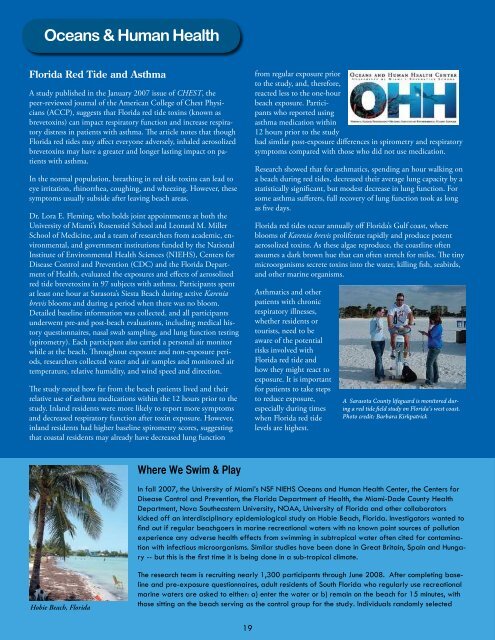

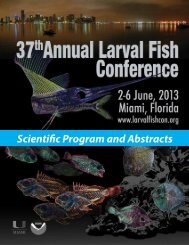
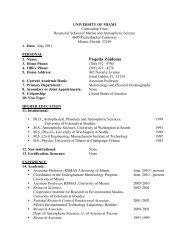
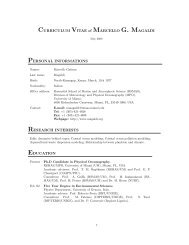
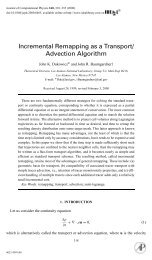
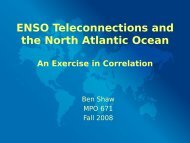
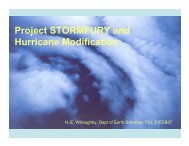
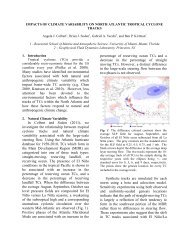
![Wavelength [μm] ZENITH ATMOSPHERIC TRANSMITTANCE](https://img.yumpu.com/26864082/1/190x143/wavelength-i-1-4-m-zenith-atmospheric-transmittance.jpg?quality=85)

